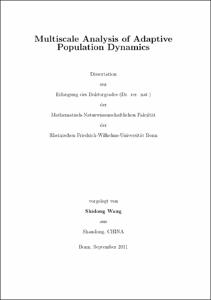Wang, Shidong: Multiscale Analysis of Adaptive Population Dynamics. - Bonn, 2012. - Dissertation, Rheinische Friedrich-Wilhelms-Universität Bonn.
Online-Ausgabe in bonndoc: https://nbn-resolving.org/urn:nbn:de:hbz:5N-27409
Online-Ausgabe in bonndoc: https://nbn-resolving.org/urn:nbn:de:hbz:5N-27409
@phdthesis{handle:20.500.11811/5089,
urn: https://nbn-resolving.org/urn:nbn:de:hbz:5N-27409,
author = {{Shidong Wang}},
title = {Multiscale Analysis of Adaptive Population Dynamics},
school = {Rheinische Friedrich-Wilhelms-Universität Bonn},
year = 2012,
month = jan,
note = {In this thesis we study a spatial population model based on a class of interacting locally regulated branching processes. The results consist of three parts which are independent of each other. The first part, which is the main part of this thesis as presented in Chapter 2 and 3, is concerned with a three-time-scale analysis of a spatially structured population specified with adaptive fitness landscape. More precisely, we obtain a new model, the so-called trait substitution tree (TST), in the limiting system by taking a rare mutation limit against a slow migration limit. These limits can be either simultaneous with a large population limit from a microscopic point of view (Chapter 3), or based on a deterministic approximation (Chapter 2). The TST process is a measure-valued Markov jump process with a well-described branching tree structure. The novelty of our work is that every phenotype, which may nearly die out on the migration time scale, has a chance to recover and further to be stabilized on the mutation time scale because of a change in the fitness landscape due to a new-entering mutant.
The second part (Chapter 4) deals with the neutral mutation case, i.e., the fixation probability of an advantageous mutant is of order $\frac{1}{K^\lambda}$ ($0<\lambda\leq 1$) in terms of a large population size $K$. We proceed by two cases. For $0<\lambda< 1$ we consider the rescaling limit on a time scale of accumulated mutations and extend the trait substitution sequence model. For $\lambda=1$ we obtain a rescaling limit in a weak sense, i.e., under conditioning on non-extinction up to observation time.
In the last part (Chapter 5) we study the fluctuation limit of the locally regulated population, and we obtain a limiting process as the solution both of a martingale problem and of a generalized Langevin equation. Under appropriate conditions we prove that the fluctuation limit and the long term limit are interchangeable.},
url = {https://hdl.handle.net/20.500.11811/5089}
}
urn: https://nbn-resolving.org/urn:nbn:de:hbz:5N-27409,
author = {{Shidong Wang}},
title = {Multiscale Analysis of Adaptive Population Dynamics},
school = {Rheinische Friedrich-Wilhelms-Universität Bonn},
year = 2012,
month = jan,
note = {In this thesis we study a spatial population model based on a class of interacting locally regulated branching processes. The results consist of three parts which are independent of each other. The first part, which is the main part of this thesis as presented in Chapter 2 and 3, is concerned with a three-time-scale analysis of a spatially structured population specified with adaptive fitness landscape. More precisely, we obtain a new model, the so-called trait substitution tree (TST), in the limiting system by taking a rare mutation limit against a slow migration limit. These limits can be either simultaneous with a large population limit from a microscopic point of view (Chapter 3), or based on a deterministic approximation (Chapter 2). The TST process is a measure-valued Markov jump process with a well-described branching tree structure. The novelty of our work is that every phenotype, which may nearly die out on the migration time scale, has a chance to recover and further to be stabilized on the mutation time scale because of a change in the fitness landscape due to a new-entering mutant.
The second part (Chapter 4) deals with the neutral mutation case, i.e., the fixation probability of an advantageous mutant is of order $\frac{1}{K^\lambda}$ ($0<\lambda\leq 1$) in terms of a large population size $K$. We proceed by two cases. For $0<\lambda< 1$ we consider the rescaling limit on a time scale of accumulated mutations and extend the trait substitution sequence model. For $\lambda=1$ we obtain a rescaling limit in a weak sense, i.e., under conditioning on non-extinction up to observation time.
In the last part (Chapter 5) we study the fluctuation limit of the locally regulated population, and we obtain a limiting process as the solution both of a martingale problem and of a generalized Langevin equation. Under appropriate conditions we prove that the fluctuation limit and the long term limit are interchangeable.},
url = {https://hdl.handle.net/20.500.11811/5089}
}






